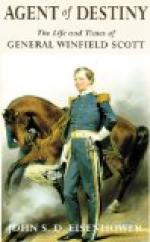On March 8, 1835, the Hon. John H. Eaton addressed a letter to Lewis Cass, Secretary of War, raising the question whether the treaty of Payne’s Landing was valid, it not having been ratified until 1834. To this the Secretary replied that, the question had been referred to the Attorney General, and that he had decided that the obligation of the treaty was not affected by the delay, but that the Indians might be required to move in the years 1835-’37.
The Indian agent called a meeting of the Indians, who assembled in council on October 23, 1834. The agent stated that he had convened them by order of the President, who said that he had complied with all the promises made to them, and that they must prepare to move by the beginning of cold weather. He further stated that he had a proposition to them from the Creeks, and exhibited a map of the country allotted to them west of the Mississippi.
The proposition from the Creeks was that the Seminoles, instead of settling in the country allotted to them, in a separate body, settle promiscuously among the Creeks. The agent stated in regard to this last proposition: “It is left, as it should be, entirely optional with you, and no persons but yourselves have any right to say you shall or shall not accede to the proposition.” Other questions were submitted, such as the disposition of their cattle, whether they preferred to march by land or go by water, and the manner in which they desired the annuity paid them. The Indians then retired for a private council, and on their return Holata Amathla said: “My brothers, we have now heard the talk that our father at Washington has sent us. He says that we made a treaty at Payne’s Landing, and we have no excuse now for not doing what we promised; we must be honest. Let us go, my brothers, and talk it over, and don’t let us act like fools.”




